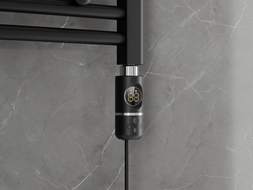
Bleeding a bathroom radiator is one of the most important tasks when the radiator is not functioning correctly. Why? There are several reasons. In the case of bathrooms, it’s not just about thermal comfort - these areas, due to their purpose, are more susceptible to mold and mildew development. Therefore, the temperature should be higher than in other parts of the apartment or house.
What if the radiator is not working properly? How to bleed a bathroom radiator? Below you will find a practical guide that will help you carry out this process step by step.
How to bleed a bathroom radiator?
Bleeding a radiator depends on its type - some bathroom radiators are equipped with a bleeding system that automatically removes air from the heating system. You can find them in our store mexen.pl.
In other cases, you need to bleed the radiator manually. To do this, follow these steps:
- prepare the right tools - you will need a flat wrench or an adjustable wrench (commonly called a crocodile wrench), a container for water, and a cloth to wipe wet elements;
- turn off the heating (turn off the thermostat) - hot water and steam escaping from the radiator could cause burns;
- locate the bleeding valve - it’s usually the so-called upper screw located in the upper part of the radiator;
- unscrew the valve - using a flat wrench, carefully turn the bleeding valve. You will hear a characteristic hissing sound - this is the air escaping from the radiator. The bleeding process will end when only water comes out of the bleeder. Remember to place a bowl under the radiator;
- if water flows out of the radiator evenly and you hear no hissing, you can close the valve - the bleeding process has successfully completed.
How to bleed a bathroom radiator without a bleeder?
If you have an older type of radiator in your bathroom that is not equipped with a bleeder, you can also remove the accumulated air yourself.
All you need to do is perform the following simple actions:
- get two flat wrenches, a bowl, and a cloth to wipe the floor;
- cut off the water supply to the radiator - turn the thermostat head to 0;
- place a bowl on the floor under the screw located between the thermostat valve and the water inlet to the radiator;
- with one wrench, unscrew the screw closer to the radiator, while using the other to hold the screw located behind the thermostat valve;
- you will hear a hissing sound indicating the air removal from the radiator; when water starts coming out, tighten the screw. Done!
How to recognize an air-locked radiator?
Despite having the radiator on in the bathroom, the room temperature doesn’t reach the expected level? The cause could be an air-locked radiator. To ensure this is not just a subjective impression, check if the radiator is air-locked. How to do this?
- Check the temperature of the radiator - touch the radiator with your hand - both the top and its bottom. This way, you will find out if the heat is distributed evenly. If some parts of the radiator are cooler than others, it probably means it is air-locked;
- pay attention to strange sounds - do you hear knocking or bubbling in the radiator? It may be that air has accumulated in it, impeding proper water flow;
- check the pressure in the heating system - too low may indicate the presence of air in the pipes and radiators. Take a reading from the gauge on the boiler or on the filling valve;
- measure the temperature in the bathroom - if it is lower than usual, and the thermostat valve is set to a constant level, it may mean it’s time to bleed the radiator.
If you notice any of the above symptoms, there is a high probability that the bathroom radiator is air-locked. Now it’s time to take action!
Causes of radiator air-locking
Air-locking in a radiator can occur for various reasons - some of them are beyond our control. In most cases, the problem can be avoided.
Here are the most common causes of radiator air-locking:
- improper filling of the system - while filling water into pipes or radiators, air may get in. This happens when the process is executed quickly and carelessly;
- leaky heating system - leaking water can cause air from outside to get into the system. Leaks can occur at pipe connections or due to damaged valves or seals;
- damaged bleeding valve - a poorly functioning system prevents air from being expelled from the radiators;
- too low pressure in the heating system;
- improper operation of the bleed valves - radiators should be equipped with bleed valves that allow the removal of accumulated air. If they are improperly used, it can lead to air-locking problems;
- contamination in the system - debris in the heating system can block water flow and encourage the accumulation of air.
Identifying the cause of radiator air-locking will help prevent the problem from reoccurring in the future. If the problem persists and self-bleeding does not yield the expected result, it’s worth consulting a professional.
Why should you bleed an air-locked radiator?
Air accumulated in the heating system can disrupt its operation, consequently preventing proper heating of the room. A correctly bled radiator will ensure effective and even operation of the device, which will also translate into energy savings.
An unevenly heating radiator, bubbling and noises of water are the most common signs of air in the radiator. However, it’s also worth remembering that air can cause corrosion inside the radiator, which will contribute to faster wear.
In this article, we described how to bleed a ladder bathroom radiator without the need to seek professional help. Remember, regular bleeding of the bathroom radiator will help maintain the proper functioning of the entire heating system in your home.



















